A History of the County of York North Riding: Volume 2. Originally published by Victoria County History, London, 1923.
This free content was digitised by double rekeying. All rights reserved.
'Parishes: Crambe', in A History of the County of York North Riding: Volume 2, ed. William Page( London, 1923), British History Online https://prod.british-history.ac.uk/vch/yorks/north/vol2/pp113-119 [accessed 26 November 2024].
'Parishes: Crambe', in A History of the County of York North Riding: Volume 2. Edited by William Page( London, 1923), British History Online, accessed November 26, 2024, https://prod.british-history.ac.uk/vch/yorks/north/vol2/pp113-119.
"Parishes: Crambe". A History of the County of York North Riding: Volume 2. Ed. William Page(London, 1923), , British History Online. Web. 26 November 2024. https://prod.british-history.ac.uk/vch/yorks/north/vol2/pp113-119.
In this section
CRAMBE
Crambun (xi cent.); Grammum, Cramburn (xiii cent.); Crampholme, Crawme (xvii cent.).
The parish of Crambe lies in the picturesque and pastoral valley of the Derwent, which separates it from the East Riding and the adjoining parishes of Howsham and Kirkham. The high road from York to Malton runs in a north-easterly direction through the townships of Barton-le-Willows and Whitwellon-the-Hill, and is crossed soon after it enters the parish by the York and Scarborough branch of the North Eastern railway, which has one station at Barton Hill and another, Kirkham station, just within the boundaries of Whitwell.
The height of the parish varies from 300 ft. to 50 ft. above the ordnance datum. The area of the whole parish is 3,794 acres, of which 1,357 acres are arable and 1,906 acres are laid down to permanent grass, while 152 acres are woodland. (fn. 1) The subsoil of Crambe and Whitwell is Upper, Middle and Lower Lias and alluvium, of Barton Keuper Marls and alluvium.
The Spittle Beck flows through Barton and Crambe south-east and east, finally, as Braisthwaites Beck, emptying itself into the Derwent. In the 16th century Leland crossed this brook half a mile from Whitwell village at a place 'communely called the Spitel corruptly for Hospitale,' (fn. 2) which has been known as the Spittle Bridge since the 14th century, when the Prior of Kirkham was charged with its repair. (fn. 3) The scouring of the beck and repair of the bridge and highway were occasionally neglected by the townsfolk of Crambe, Barton and Whitwell in the 17th century. (fn. 4)
Whitwell-on-the-Hill, the largest of the three villages, is mainly built on the summit of a ridge some 250 ft. high along a lane running westward from the main road, though the school and the church of St. John the Evangelist lie by the highway. Close to the church is the manor-house, formerly the residence of the late Mr. Digby Cayley, J.P. There was a manor-house in Whitwell in 1670. (fn. 5) Whitwell Hall, the property of Sir E. A. Lechmere, bart., lies in park land to the west of the village. It was built about 1830 by Joseph Haigh. Included in the stable buildings is the old chapel of Whitwell. It has been largely altered and rebuilt, and has a three-light traceried east window of 15th-century character. The roof is modern.
A mile or more south-east the picturesque little village of Crambe with its church of St. Michael and old school buildings lies in a deep hollow open on the south to the Derwent valley and away from the main road. The capital mansion called the Hall Garth, which had belonged to Kirkham Priory, was the subject of various leases by the Crown from 1565 to 1588, (fn. 6) while Nicholas Wilson held a capital messuage in the other moiety of the manor. (fn. 7) In the south-west of the parish is Barton-le-Willows, where the houses cluster round a large green. It contains a small modern chapel of ease built of brick in 15thcentury Gothic style with a four-light east window. Here the Prior of Kirkham had a 'demesne messuage' in the time of Edward III. (fn. 8)
The children of all three villages attend the provided school erected at Whitwell in 1874. There has been a small Wesleyan chapel at Barton-leWillows since 1823. (fn. 9) In 1890 a reading room and library were opened in Whitwell, where there is also now a convalescent home in connexion with the York hospitals.
Some 16th-century place-names in this parish are those of the Severall pasture and Prior Arme in Crambe Inges in Crambe, and Bosseledaleyng in Barton, all once possessions of Kirkham Priory. (fn. 10)
A few prehistoric remains have been found in this parish. (fn. 11)
Manors
A 'manor' and 4 carucates in CRAMBE which had once belonged to Sumorled were reckoned among the Conqueror's estates in 1086, but after the returns of the Survey were included in a fief granted to Robert Brus. (fn. 12) Between the foundation of Kirkham Priory in 1122 and 1167, when 'the Canons' were associated with Walter Percehay in a plea connected with Crambe, (fn. 13) most of this fief seems to have been granted to that house. The prior was lord of lands here in 1252, 1279 and 1301, and was returned in 1316 as one of the two principal landowners. (fn. 14) Again in 1347 and 1428 he was found to hold of the Brus fee 3 carucates in Crambe, (fn. 15) which came to the Crown in 1538 on the surrender of the priory. (fn. 16) Edmund Forster, who then held the manor, (fn. 17) had been followed by other lessees before 1590, when Elizabeth granted its reversion to Thomas Bamburgh, (fn. 18) son and heir of Thomas Bamburgh of Howsham. (fn. 19) The new lord was succeeded in 1593 by his eldest son William, (fn. 20) created a baronet in 1619. (fn. 21) Sir William's two sons, Thomas and John, who succeeded him in turn, both died minors and unmarried, (fn. 22) and the family estates descended to the sole survivor of their five sisters, (fn. 23) Katherine, then wife of Sir John Hotham, and their nephews Thomas Wentworth of North Elmsall and William Robinson of Newby, the sons of their sisters Mary and Amy. (fn. 24) Katherine Hotham died in 1634 and was succeeded in her third of the Bamburgh estates by Thomas her son and heir by a first husband, Sir Thomas Norcliffe. (fn. 25) The next year proceedings were instituted in the Court of Wards and Liveries against Sir John Hotham on behalf of his stepson, then aged eighteen, who prayed that he might not be married without the consent of the Lady Fairfax (Mary widow of Sir William Bamburgh, then married to Thomas Viscount Fairfax of Emley) and that Sir John's reflections on his grandmother and her second husband might be expunged. (fn. 26) Apparently the Fairfaxes won their case, for in 1639 Thomas Norcliffe married Dorothy daughter of Sir Thomas Fairfax by his first wife. (fn. 27) About the same time a settlement of another third of the Bamburgh estates then held by Thomas Wentworth was made, apparently as a preliminary to his marriage with Agnes daughter of Sir Henry Bellingham. (fn. 28) William Robinson, the third co-heir, died unmarried in 1643, when his heirs were found to be Thomas Wentworth and Thomas Norcliffe. (fn. 29) It is probable that the moieties of the manor of Crambe, henceforward held by these two cousins, were united within the next thirty years by the marriage of Sir John Wentworth, son and heir of Thomas Wentworth and Agnes Bellingham, with Katherine daughter of Sir Thomas Norcliffe. Thomas, their son and heir, died without issue in 1689, and his estates descended to his cousin John son and heir of his father's younger brother Henry. (fn. 30)
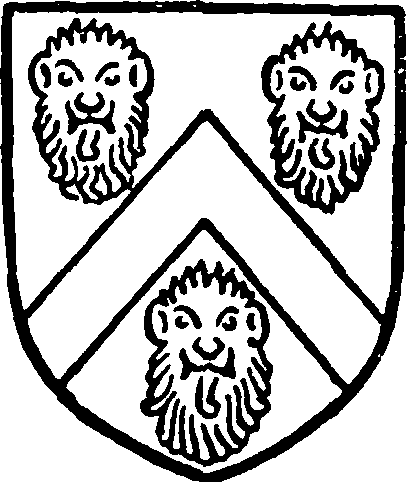
Wentworth. Sable a cheveron between three leopards' heads or.
By his second wife, Lady Elizabeth Cavendish, John Wentworth, created baronet in 1692, had an only son and heir, Sir Butler Cavendish Wentworth, (fn. 31) who was lord of the manor of Crambe in 1731 and 1736. (fn. 32) On Sir Butler's death in 1741 the Wentworth estates passed to his half-sister Katherine Wentworth, then wife of Hugh Cholmeley, (fn. 33) who held the manor with her in 1745. (fn. 34) Their son and heir Nathaniel Cholmeley of Whitby and Howsham left no male issue, and Crambe eventually descended to Sir George Strickland, son of Nathaniel's third daughter and co-heir Henrietta wife of Sir William Strickland. In 1874 Sir George was succeeded by his son and heir Sir Charles William Strickland, who died in 1909, and was succeeded by his son, Sir Walter William Strickland, ninth baronet, the present lord of the manor. (fn. 35)
Another 'manor' in Crambe, also of 4 carucates, which had belonged to Waltheof, was held by Robert Count of Mortain at the Survey. (fn. 36) It is likely that this was afterwards held of the count by his tenant Richard de Surdeval, who became tenant in chief of many of his overlord's lands after their final forfeiture. (fn. 37) Maud, perhaps daughter of Richard, and her husband Ralph Paynel were probably in possession of Waltheof's manor as well as of his moiety of the church, (fn. 38) which their son Alexander described as 'of my fief.' (fn. 39) Alexander's granddaughter, or great-granddaughter, Frethesent brought considerable estates in Yorkshire to her husband Geoffrey Luttrell, (fn. 40) and a fee in Crambe of the same extent as Count Robert's Domesday manor was held in 1300 of their great-grandson, another Geoffrey Luttrell. (fn. 41) Andrew his son was overlord in 1347, (fn. 42) and was succeeded by his son, another Andrew Luttrell, of whom the manor was held in 1384. (fn. 43) The last male heir of this branch of the Luttrell family died without issue in 1417, (fn. 44) and within ten years their rights in Crambe had passed to Lord Latimer. (fn. 45) Another Lord Latimer was declared to be overlord in 1510, (fn. 46) but in 1586, when the last mention of the overlordship of this manor occurs, it was found to be held of the queen as of the manor of Sheriff Hutton. (fn. 47)
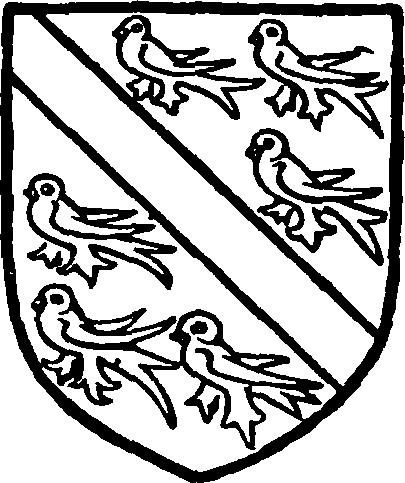
Luttrell. Or a bend and six martlets sable.
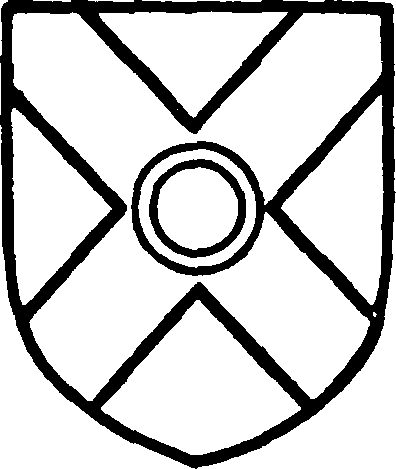
Nevill, Lord Latimer. Gules a saltire argent charged with a ring sable for difference.
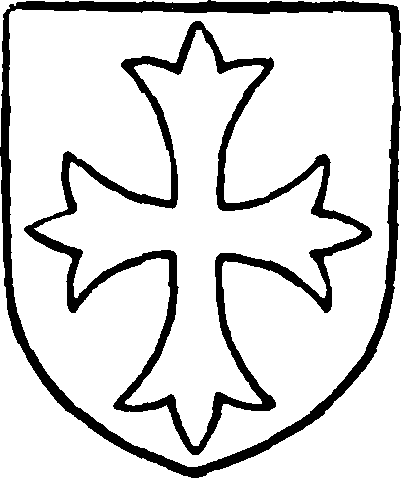
Percehay of Ryton. Argent a cross paty gules.
The sub-tenants of the Paynel and Luttrell lords of Crambe belonged to the family known from the 14th century as the Percehays of Ryton, (fn. 48) descendants probably of one Walter Percehay, whose name was associated with Crambe in 1166 or 1167. (fn. 49) More than 120 years later the manor was held by Joan Percehay, (fn. 50) possibly the widowed mother of the Walter Percehay who was lord of Ryton (q.v.) in 1284–5. (fn. 51) William son of Walter in 1344 made his will in which he mentioned his son and heir William Percehay (fn. 52) whose son and heir Sir William Percehay was seised of the manor of Crambe at his death in 1384. (fn. 53) It then descended to his son Robert, who was involved in the rebellion of 1405 and suffered temporary forfeiture of his lands, obtaining pardon, however, in 1407. (fn. 54) At his death in January 1426–7 one-third of the manor of Crambe was returned as part of his estates. (fn. 55) His son John and widow Joan held the Luttrell fee in conjunction with other tenants in 1428. (fn. 56) John was followed by a son Edmund, father of Sir Lionel (fn. 57) or Lyon, on whose death in 1482 these lands passed to his son of the same name. (fn. 58) By the second Lyon's sons Walter and William (fn. 59) Crambe was sold in or before 1523 to Sir William Compton, (fn. 60) at whose death from the sweating sickness in 1528 (fn. 61) the manor was held by trustees for himself and his heirs. His only child Peter died a minor, leaving a son and heir Henry, (fn. 62) afterwards Lord Compton, (fn. 63) by whom in 1572 the manor of Crambe was sold to Nicholas Wilson, a Prebendary of York. (fn. 64) At his death fourteen years later Nicholas was succeeded by his eldest son and heir of the same name, (fn. 65) who with his wife Frances sold the manor to William Bamburgh in 1594. (fn. 66) It is probable that from that date it was absorbed in the manor once of Kirkham Priory, which already belonged to the Bamburghs, and followed its descent, but in 1617 and 1619, and again in 1650, (fn. 67) a branch of the Metcalfe family enjoyed considerable possessions in the parish and onethird of a manor here.
The 'manor' of WHITWELL (Witevella, xi cent.; Whytewell, xiii cent.) and 5 carucates of land belonged to Waltheof in the reign of Edward the Confessor. Before the Survey it had come into the possession of the Count of Mortain, who united to it other lands in the township once held by Orm, Archil and Norman. (fn. 68) When Count Robert's estates escheated Whitwell seems to have been granted to Walter Espec, who in 1122 gave it to the priory he was then founding at Kirkham. (fn. 69) It was among the possessions which the prior and canons proposed to cede to the monks of Rievaulx at some date before 1139, but the agreement was not carried into effect and the manor remained with the older house. (fn. 70) In 1252, and again in 1293, the prior was the acknowledged lord. (fn. 71) He was returned as sole landholder in 1316, (fn. 72) and the manor remained in possession of his house until its dissolution. (fn. 73)
In 1540 Henry VIII included it in a grant of the estates of the late monastery of Kirkham to Sir Henry Knyvett and his wife Anne. (fn. 74) Anne survived Sir Henry and her third husband John Vaughan (fn. 75) until 1582, when Kirkham and Whitwell Manors descended to her son, another Sir Henry Knyvett. (fn. 76) Three years later the second Sir Henry, in conjunc tion with his brother Thomas, alienated both estates to Francis Vaughan, (fn. 77) their mother's son by her third marriage. (fn. 78) A settlement of Whitwell was made by Francis and his wife Anne in 1596 on the marriage of their son and heir Henry with Susan daughter of Edward Stanhope of Grimston. (fn. 79) In the following year Francis was slain in an obscure skirmish, fighting against the rebels in Ireland, (fn. 80) and Henry succeeded him at the age of sixteen. (fn. 81) His tenure, extending over nearly sixty years, was chequered by various embarrassments. It was possibly in consequence of financial difficulties inherited from his father that he leased part of his lands in Whitwell when he attained his majority (fn. 82) and mortgaged or sold other family estates in 1614 and again in 1647 and 1649. (fn. 83) In 1651 he and his wife Clare were under suspicion 'for feloniously and traytorously harbouring' Richard Montaigne, (fn. 84) a Royalist, who had openly proclaimed Charles II king at New Malton and been found shortly afterwards at Kirkham in the company of Thomas Vaughan. (fn. 85) Sir Henry had already been compelled to compound as a delinquent, and when he fell ill on an expedition to borrow money to meet the very heavy fine inflicted on him the sum he had procured was seized by the Parliamentarian agent. (fn. 86) The records of the sessions held in this part of the North Riding abound in references to the suits and complaints brought against him by his neighbours, and in 1654 their attacks culminated in the indictment of Sir Henry Vaughan and his wife Dame Clare as 'common barrectors.' (fn. 87) Sir Henry was succeeded by his son Thomas, who seems to have died without issue, for the manors of Kirkham and Whitwell afterwards descended to Francis elder son of Sir Henry's other son John. (fn. 88) John Vaughan, who had fought for King Charles, died in or before 1649. (fn. 89) Of his two sons, Francis and Henry, both also Royalist soldiers, the elder was outlawed for manslaughter in 1658, 'and soe dying,' as his brother wrote to the king two years later, 'the estate of Whitwell and Kirkham in the county of York became forfeited to your Majesty.' The petition of Henry Vaughan, who had served his king beyond seas (fn. 90) and only returned to England in 1659, (fn. 91) was answered by a grant, made in December 1660, of the manors of Kirkham and Whitwell to his nominees Edward Stanley and William Thursby. (fn. 92) The next year the manor of Whitwell was transferred by them to Henry Vaughan, (fn. 93) on whom they finally settled the whole of his inheritance in 1662. (fn. 94) Within two years Henry had been succeeded by his three sisters and co-heirs, one of whom, Susanna, in August 1664, made a settlement of her third of the family estates on Thomas Marshall, probably already husband of her sister Anne, and Richard Etherington, as a preliminary to her marriage with Herbert Jeffreys. (fn. 95) Their respective shares in the two manors were mortgaged by Herbert Jeffreys and his wife Susanna in 1666, and in the two following years by William Bonner and his wife Douglas and Thomas Marshall and his wife Anne. (fn. 96) In 1670 the three sisters, Susanna, Anne and Douglas, in conjunction with their husbands, sold Whitwell Manor to Sir Ralph Ashton, Sir William Ingleby and Henry Marwood, (fn. 97) who were probably acting as trustees for Alan Bellingham of Levens, Westmorland, for whom a fortnight later they acquired other property. (fn. 98) From Alan Bellingham the manor descended to his son Henry, whose daughter and heir Frances, in or before 1702, brought it in marriage to Sir Reginald Graham, bart. (fn. 99) Their grandson Sir Bellingham Graham, (fn. 100) who made a settlement of one-fourth of the manor of Whitwell in 1765, (fn. 101) was succeeded by his son and heir of the same name. (fn. 102) At his death Sir Bellingham's estates descended to his son Sir Bellingham Reginald Graham, lord of Whitwell in 1810. (fn. 103) Whitwell was bought in 1829 by John Haigh for £105,000. (fn. 104) He died within a few years and his son and successor died in 1837, when the estate passed to his sister Miss Louisa Rosamund Haigh, who attained her majority in 1858 and brought Whitwell by marriage to Sir Edmund Anthony Harley Lechmere, bart., (fn. 105) who died in 1894. Their son and heir Sir Edmund Arthur Lechmere is the present lord of the manor.
The three 'manors' of BARTON-LE-WILLOWS (Bartun, xi cent.), once held by Turchel, Gamel, and Scanchel, and containing 8 carucates, had been united into one in the possession of the Count of Mortain before 1086. (fn. 106) This probably came with Whitwell to Walter Espec, whose sister and co-heir Odelina by her marriage with Peter de Roos became ancestress of the family of Roos of Hamlake. (fn. 107) From 1253 the overlordship of this manor followed the descent of Helmsley (fn. 108) (q.v.).

Vaughan. Sable a cheveron argent between three boys' heads with serpents entwined about their necks all in their proper colours.
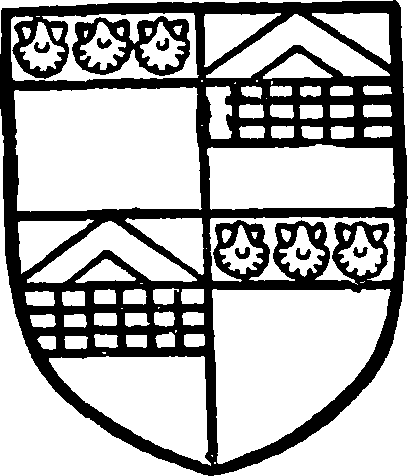
Graham of Norton, baronet. Or a chief sable with three scallops or therein, quartered with Or a fesse checky argent and azure with a cheveron gules in the chief.

Lechmere, baronet. Gules a fesse or with two pelicans or in the chief.

Barton of Oswaldkirk. Ermine a fesse gules with three rings or thereon.
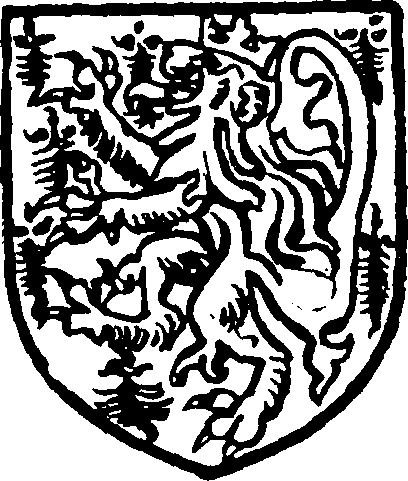
Pickering. Ermine a lion azure with a golden crown.
From the 13th to the 16th century the manor seems to have been generally broken up into small fees sometimes corresponding in number to the three holdings of which it had consisted before the Norman Conquest. (fn. 109) The earliest tenants whose names have been preserved are the Bartons of Oswaldkirk. Alan de Barton held land in Barton in 1204, (fn. 110) and the first of three Williams de Barton, father, son and grandson, (fn. 111) is described in the charter of 1336 which records their gifts to Kirkham Abbey as 'lord of Barton.' (fn. 112) There is more definite information about the tenure of the Pickerings and Bruses, with whom the Bartons were connected. (fn. 113) In 1285 and 1294 Adam Brus of Pickering was acquiring land and other property in the township from Peter de Roos, Peter son of Peter and Thomas Russell, (fn. 114) fifteen years later his brother Robert de Pickering held the third of a knight's fee here, (fn. 115) whilst a third brother, William de Pickering, paid in the following year a large share of the subsidy then raised in Barton. (fn. 116) In 1316 Robert, who had succeeded his brother William in the deanery of York four years before, (fn. 117) was returned as sole lord. (fn. 118) He died in 1332, (fn. 119) and before 1335 his estate had descended to William (fn. 120) son of his brother Adam Brus, who was William Pickering's heir in Oswaldkirk. (fn. 121) William Brus, who in 1325 had bought lands in Barton from Richard son of Stephen de Strensall, (fn. 122) and was the wealthiest tenant in 1327, (fn. 123) was still holding the third of a knight's fee in 1343. (fn. 124) Nine years later he had been succeeded by his widow Maud, then wife of Alexander Nevill. (fn. 125) Part of a knight's fee in 'Barton in Bulmershire' was in 1415 in the possession of Joan Brus, (fn. 126) possibly a widow holding under a settlement; William Brus in 1428 is named as the first of several tenants here. (fn. 127) At some later date the manor of Barton-le-Willows came into the possession of the Ecclesfield family through the marriage of Elizabeth, one of the three daughters and coheirs of Sir William Brus, with Richard Ecclesfield. (fn. 128) Their son Robert was probably an ancestor of Brian Ecclesfield, who was seised of the manor of Barton-leWillows at his death in 1539. (fn. 129) It then descended to his eldest son Thomas, whose grandson Francis in 1591 conveyed some part of his rights to Francis Nuttall, (fn. 130) and sixteen years later in conjunction with Ashton Nuttall and his wife Hester sold the manor of Barton-le-Willows to Sir William Bamburgh. (fn. 131) Its descent from 1607 has been identical with that of the manor of Crambe (q.v.).

Ecclesfield. Argent three eagles gules.
In the 14th and 15th centuries small fractions of a knight's fee in Barton were held of the Roos lords by the families of Borcher and Hill. (fn. 132) The undated grant by William 'lord of Barton' of land and pasture to Kirkham Priory was followed by similar gifts from his heirs and other donors, (fn. 133) one of whom, Emma Lovell, received in return from the prior a skep of corn and a skep of lilies and an annual present of a mantle worth 4s. (fn. 134) Some part of the holding of Kirkham Priory in Barton, valued in 1535 at £3 per annum, (fn. 135) was afterwards granted to John Farnham. (fn. 136)
In 1709 or 1710 a 'manor of Barton-le-Willows,' which may have been composed of these tenements, passed from Henry Cutler and his wife Elizabeth to John Savile and Francis Foljambe. (fn. 137)
The Prior of Kirkham had a grant of free warren in Whitwell and Crambe in 1252, (fn. 138) his right to the assize of ale, according to his own showing forty-one years later, dating from time immemorial. (fn. 139) In both Crambe and Whitwell he held view of frankpledge and court leet. (fn. 140)
Free warren in Barton was enjoyed by William Brus and his heirs from 1335. (fn. 141) In this township there was a fishery called Barton Pool which once belonged to the monks of Kirkham Priory. (fn. 142) Both Barton and Whitwell Manors had dovecotes, and in the 13th century Emma Lovell granted land to William Hill (Hull) on condition that he should grind corn at her mill in Barton. (fn. 143)
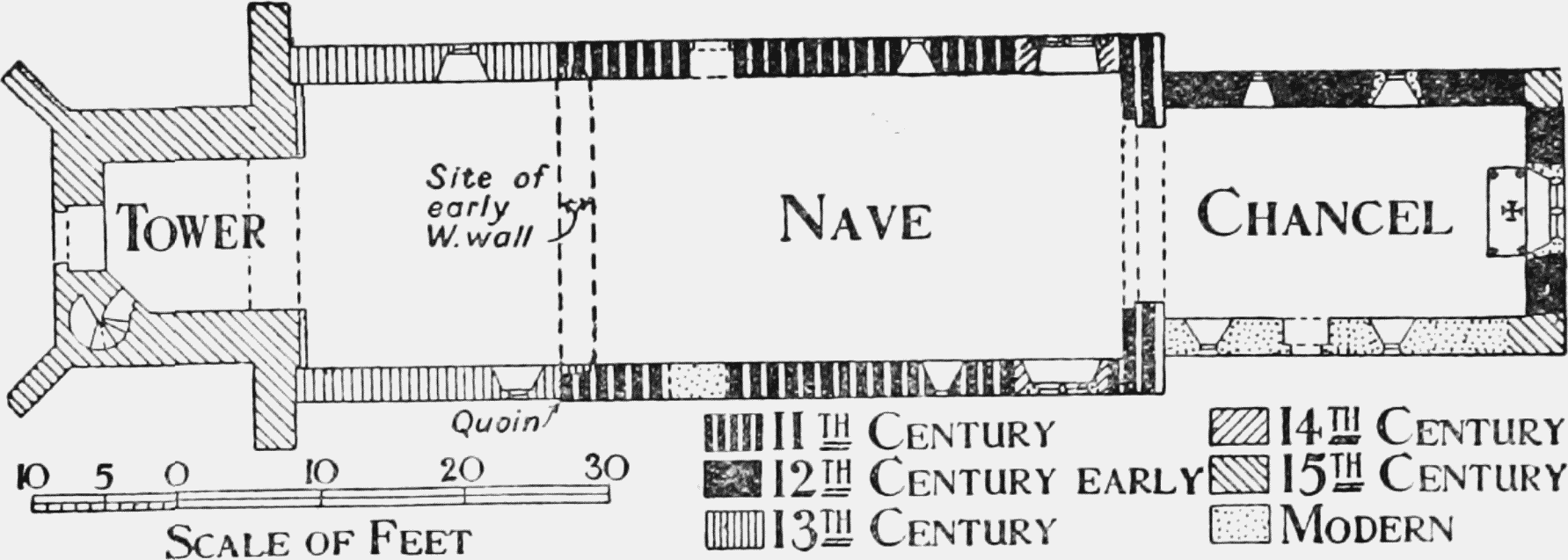
Plan of Crambe Church
Churches
The church of ST. MICHAEL consists of a chancel 28 ft. by 14½ ft., a nave 55 ft. by 19½ ft., and a western tower 10½ ft. square, all measurements being internal. The earliest portions of the existing building appear to date from the 11th century and may be either before or after the Conquest. At this date the nave was about 38 ft. long only, and the north and south walls with the chancel arch are still standing. The chancel was apparently rebuilt early in the 12th century. The next alteration was the removal of the west wall of the nave and the addition of about 17 ft. to its length; this was done in the 13th century, and the lines of junction between the two periods are still quite evident. At the same date the north door was altered. In the 14th century the eastern angles of the chancel were reconstructed and a pair of two-light windows inserted at the east end of the side walls of the nave. In the following century the west wall was rebuilt and the tower added. The church has been restored in modern times, and the east gable and south wall of the chancel largely rebuilt.
The east window is a modern pointed one of two lights, and three of the side windows, the first on the north and two on the south, are modern singlelight openings. Between the two latter is a pointed priest's door also new. The second window in the north wall is the only original one left in the chancel, and is a narrow round-headed 12th-century light, the eastern jamb of which has long and short quoins. The chancel arch is of very rude construction and of unusually large span for its early date. It is about 12 ft. wide and quite plain; the responds are square and have roughly chamfered imposts, and the voussoirs of the arch are not set radially, but depressed on either side with a larger wedge-shaped stone set in the head as a key. The inner face of the arch is set back on either side some 3 in. from the face of the responds, and above it is a relieving arch of similar construction. The whole arch has subsided, throwing the nave walls, especially the southern, seriously out of the perpendicular.
The first two windows in the nave are restorations of apparently 14th-century openings and are both of two lights. Further west is a pair of original 11thcentury windows, one on each side, placed high up in the walls and having round-headed single lights of very small dimensions; that on the south has the head carved externally with knot work. The north door, which is the main entrance to the church, is the 11thcentury opening altered in the 13th century. A corresponding south door with a plain semicircular arch is now walled up. The two angles of the original nave are visible immediately to the west of these doors on the outside of the building. The western part of the nave is of 13th-century date with a single lancet window in each wall. The west wall was reconstructed when the tower was built and is supported by 15th-century buttresses of three offsets.
The 15th-century tower is a handsome structure three stages high and opening into the nave by an arch springing from grotesques, that on the south, a large face, appearing to be of considerably earlier date. The west door is round-headed, but of 15th-century work, and above it is a three-light window with a traceried semicircular head. The second stage of the tower is blank except for a loop in the west wall, and the belfry is lighted by a two-light round-headed window in each face with cusped heads and a trefoil in the spandrel. Externally the tower is faced with ashlar and supported at the western angles by diagonal buttresses of five and six offsets respectively. The stages are marked by string-courses and the parapet is embattled with crocketed pinnacles at the angles and in the centre of each side.
The walling of the ancient portions of the church is of small rubble and the roofs are modern and slated. The fine late 12thcentury font has a square bowl, the sides of which are ornamented with a shallow interlacing arcade of round arches. It rests on a central and four subsidiary piers, all cylindrical, and all having moulded bases standing on a common square plinth. The capitals of the smaller piers have carved foliage somewhat mutilated.
The communion rail rests on old turned balusters and the octagonal pulpit is Jacobean, the sides having enriched arches and panels. It stands on a modern base. In the quire are modern monuments to the last members of the Cholmeley family of Whitby Abbey.
On the eastern jamb of the first window on the south side of the nave is an inscription running 'Hic infra jacit corpus Thom[as] Stubley An[n]o D[omini] 1602.'
There are three bells: the first dated 1727, the second inscribed 'Deo Gloria 1761,' and the third 'Gloria in excelsis deo 1677.' An oak beam of the bell frame bears the date 1619.
The plate consists of a cup without mark or inscription, but apparently of the 17th century, a small modern paten and a plated set of cup, flagon and two patens given in 1863.
The registers before 1812 are as follows: (i) mixed entries 1711 to 1758; (ii) baptisms 1759 to 1801, burials 1759 to 1793; (iii) marriages 1754 to 1812; (iv) baptisms 1802 to 1812 and burials 1793 to 1812.
The modern church of ST. JOHN THE EVANGELIST at Whitwell was built in 1860 from the designs of G. E. Street. The style adopted is Gothic of late 13th-century character, and the building consists of an aisleless nave and chancel with a tower on the south of the latter, the base of which forms an organ chamber. The three-light east window has geometric tracery in the head. The stone spire is squat and somewhat heavy, as is most of the detail employed in the building. On the south side is a modern churchyard cross.
Advowson
The history of the church of St. Michael can be traced back to 1086, when the parish of Crambe had a church in moieties which belonged to its two manors respectively. There is reason to believe that it was the moiety of the Count of Mortain, in whose fee, according to the Survey, were one priest and one church, (fn. 144) which was given by Ralph Paynel to the priory of Holy Trinity, York, (fn. 145) and ceded by Philip, prior here in 1175, to the church of Kirkham and its canons, (fn. 146) to whom the other moiety had already probably been given with the manor. (fn. 147) A pension of 40s. was henceforward paid to the Prior of Holy Trinity from the church of Crambe, (fn. 148) which remained amongst the possessions of Kirkham Priory until its surrender. (fn. 149) In 1545 the church and advowson were given by Henry VIII to the see of York in exchange for certain manors, (fn. 150) and this grant was renewed eleven years later by Philip and Mary. (fn. 151) The patronage belonged to the archbishop (fn. 152) until 1868, when by an exchange of benefices it was vested in the Crown, (fn. 153) and the Lord Chancellor still presents.
The rectory, which had been appropriated to Kirkham Priory before 1291, when a vicarage had also been ordained, (fn. 154) has always followed the descent of the advowson.
A manse, glebe land and tithes have belonged to the vicarage of Crambe since 1535. (fn. 155) The rectory tithes, tithe barns and lands in Crambe, Huttons Ambo and Henderskelfe were included in the grant to the Archbishop of York. (fn. 156)
In 1391 Patrick Barton, rector of Catwick in Holderness, left £20 to the 'fabric of the church of Barton in Bulmershire.' (fn. 157)
A separate district was formed in 1861 for the church of St. John the Evangelist in the township of Whitwell-on-the-Hill, which had been built by Sir Edmund and Lady Lechmere. (fn. 158) Sir Edmund A. Lechmere, bart., is patron of the vicarage.
Charities
A sum of £17, given to the poor by — Surr, which was formerly held on personal security by a Mr. William Joye of Crambe, has been lost.
A Wesleyan chapel was erected at Barton-leWillows in this parish, and a scheme of the Charity Commissioners was established in 1881 for its administration.
